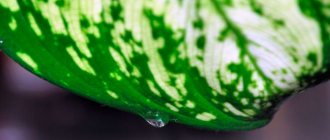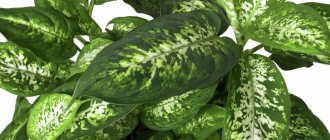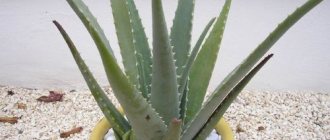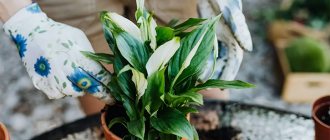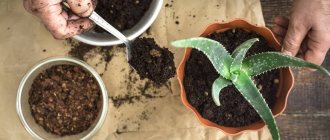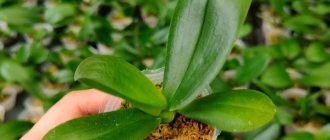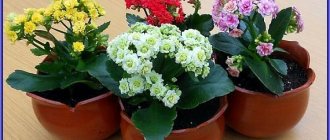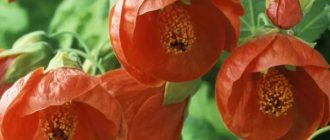Dieffenbachia - reproduction
Question: Everyone’s Dieffenbachia cuttings easily take root in water, but mine drops leaves and rots?
Natali: In order for Dieffenbachia to take root safely in water and not rot (loss of leaves is quite acceptable), you need to take clean water, not boiled, but preferably filtered, add 4-5 tablets of activated carbon per half liter, do not keep the jar of water in the light ( You can wrap it in a napkin) and change the water periodically for fresh water. You can also root in a weak fertilizer solution. Any fertilizer for decorative foliage plants, taken in a dose 4 times less than recommended for root feeding.
If rotting (the bottom of the cutting becomes slimy and darkens) has begun, then you can cut off the damaged part of the stem to healthy tissue, rinse the cutting in running water, place it in fresh water, to which add a few drops of phytosporin. After 2-3 days, replace the water with fresh water, add phytosporin again, but 2 times less. If there is no phytosporin, add ground cinnamon on the tip of a knife.
If Dieffenbachia is rooted in the ground, then it does not need to be covered with a bag or jar, but the cuttings must be sprayed 2 times a day. And the soil should be kept only slightly moist. Of course, the soil should be sterilized (soak it in the microwave for about 3 minutes), and the cut of the cutting should be sprinkled with crushed charcoal.
Caring for Dieffenbachia - in the section of the Encyclopedia of indoor plants.
Kroky: A possible reason for the trunk rotting in water is the cut touching the bottom of the jar. Try to arrange it somehow so that the cut hangs in the water. You can also sprinkle the cuts with charcoal. The leaves, by the way, have the right to turn yellow and fall off in the process, don’t be alarmed. And cuttings from the trunk need 2-3 rings.
aie13: I root exclusively in water: a 3-liter jar of boiled water + 5 tablets of activated carbon, I wrap the jar with a black garbage bag (so that it is dark in the jar). The crown in the cut-off state is usually about a meter long, I dry the cut for 2-3 hours and put it in a jar, it was very correctly noted earlier that the cut should not touch the bottom - otherwise 50% of the decay is inevitable. After 3-4 weeks, small roots appear - now into the ground. Inevitably I lose a few of the lower leaves.
Question: I’m trying to root a Dieffenbachia cutting, but nothing is working!
Reproduction of Dieffenbachia - in the section Popular indoor plants
polin: When rooting Dieffenbachia cuttings, I noticed an interesting trend - if the cutting is apical, then the roots take longer to appear than if the cutting is cut from the middle of the trunk (without the top). Maybe with two tops the rooting process is naturally delayed?
Kroky: Indeed, the higher up the trunk, the longer the roots take to grow. In root cuts, roots can appear within a week. Therefore, there is little point in comparing the rate of root appearance in different people. Even on thin, recently grown shoots, roots will also appear faster than on old, thick ones. But the latter will develop large leaves faster.
Lelya: My stalk (it has dropped all its leaves) has been sitting in the water for about 20 days and only now a tubercle has appeared and a hint of a new leaf.
Elena: I rooted Dieffenbachia twice. The first time in the ground under a jar, the second time in water with activated carbon. The second method is much easier; my Dieffenbachia took root in two weeks.
How to transplant Dieffenbachia with a long stem?
Sometimes it becomes necessary to replant a plant with a long trunk. As a result, its appearance becomes unaesthetic. This problem can be easily solved by circumcision.
When working with the trunk of an adult plant, you will need the following tools and materials:
- latex gloves;
- knife;
- alcohol;
- warm water or soap solution.
Experts do not recommend pruning a plant whose trunk has not reached 3-4 cm in diameter. To encourage Dieffenbachia to bush, the easiest way is to cut off the top. In this case, the dormant side buds will come to life and the flower will grow in breadth.
The top of the flower can also be planted near a trimmed stump, resulting in a beautiful and lush bush. Subsequently, the top will take root and can be planted in a separate pot.
Attention! When cutting Dieffenbachia, a toxic white liquid is released abundantly. The juice of the plant that gets on the skin can cause a severe burn. Therefore, it is necessary to protect your hands with gloves while working.
To reduce the amount of sap released when cutting the stem, you can stop watering the plant a few days before pruning. If the trunk is too strong and you cannot cut it with a regular knife, you should try using a wood saw.
Before pruning, the tool must be disinfected with alcohol . At the end of the procedure, work equipment should be washed to remove any remaining toxic juice.
This video shows how to transplant a large Dieffenbachia flower into a self-watering pot. In this case, coconut substrate is used:
It is convenient to combine flower transplantation with its propagation. Dieffenbachia reproduces in the following ways:
- seed;
- aerial cuttings;
- stem cuttings;
During pruning, part of the removed stem can easily be used to plant a new plant. The long removed stem can be cut into several parts and planted in separate containers with prepared soil.
Dieffenbachia after pruning
Question: The trunk of my Dieffenbachia has begun to become bare. It's not very pretty. I want to plant a second one in this pot. Tell me, if I cut off the top and root it in water, what will happen to the mother plant. How will Dieffenbachia continue to grow without a crown?
polin: Without a crown - it will send out side shoots. That's all. I chop my healthy one like firewood every 2 years.
Alla Viktorovna: I also cut mine in half, the top took root in the water, and the stump produced a new shoot from the upper bud in the area of the “bridge” on the trunk. Now I have two Dieffenbachia!
Secrets of care
In nature, Dieffenbachia grows in hot climates in swampy areas. One of the main secrets of growing a plant is maintaining a watering . The main thing here is not to dry it out, but also not to overdo it. If you guess the balance necessary for your plant, it will delight you with its lush green appearance.
In winter, Dieffenbachia “drinks” less: 500-700 ml per five-liter pot every three days is enough. But in the summer, wildly growing plants need more abundant watering - a liter of water or more almost every day (in hot weather) or every other day (in cloudy weather).
Beware of excessive waterlogging: with too much water, the roots will rot, the leaves will wither, and new shoots will stop growing.
Dieffenbachia with inflorescence Photo: ru.wikipedia.org
Dieffenbachia leaves drying out
Question: I recently purchased Dieffenbachia, and when I brought it home, I discovered several black spots on the leaves. They increase in size.
Natali: The leaves of your Dieffenbachia do not turn yellow, but dry out, acquiring a dark, blackish color. This is a sign of waterlogging - it was systematically filled in at the store. It is necessary not only to replant into new soil, but also to observe the watering regime. You can also use fungicides against root rot; ask the store for drugs that help against late blight; you can pour in a solution of phytosporin.
- If the leaves of Dieffenbachia dry out and become light, like parchment, the reason is due to overdrying or too dry (and hot) air. Dieffenbachia likes humidity to be around 50-60%. If spraying 2-3 times a day does not help, you need to purchase an air humidifier or cover the batteries with damp terry towels.
Question: Why do the ends of Dieffenbachia leaves dry out?
Natali: In such cases, it is customary to go straight to the dry air in the room. Indeed, if the room is very hot and dry, the ends of the leaves of Dieffenbachia may dry out, but if the plant is not located next to the heating system, then dry air is not always the cause, or not the only cause, of dry tips and edges of the leaves. More often, the culprit is over-drying of the earthen coma, lack of nutrition, especially in large specimens that have not been replanted for several years, as well as pests - mites or thrips, which are quite difficult to notice on variegated leaves.
The most popular indoor types of Dieffenbachia.
• Spotted Dieffenbachia (Dieffenbachia maculate, D. picta, painted ). The leaf pattern may vary depending on the variety. The oval-shaped leaves reach a size of 60-70 cm and are decorated with specks and ivory-colored spots. Spots on the surface of the leaf can be small or large, merging into a single whole, as, for example, in the varieties Rudolph Roehrs, Exotica, Camilla, Marianne.
• Dieffenbachia bausei . A popular indoor plant, reaching 80-90 cm in height at home. The yellow-green leaf, 25-30 cm long, is decorated with white specks and a very unusual marble pattern.
• Lovely Dieffenbachia amoena, D. seguine, D. Seguina . The leaf is oval, oblong, reaches 60 cm in length. The dark green leaf blade has an interesting marble pattern with cream-colored spots and streaks along the lateral veins. For example, there is a very beautiful variety “Tropical Snow” with an interesting pattern on the leaves.
• Dieffenbachia bowmannii . Large oval leaves, reaching a length of 65-75 cm. A wide light vein runs along the central part of the leaf, from which small specks and streaks of cream color radiate.
• Dieffenbachia oerstedii . The leaf blade can have an elongated heart-shaped or oval-pointed shape. Dieffenbachia Oersted's leaves are a solid dark green color, unlike the variegated leaves of other species. Against the background of the dark green color of the leaf, a wide white central vein stands out clearly.
Dieffenbachia leaves turn yellow
Question: The leaves of Dieffenbachia suddenly began to turn yellow, a visual inspection did not show any pests, what could be the reason?
Alexander: If the leaves suddenly turn yellow, it’s overwatering. And the roots begin to rot. It is necessary to ventilate them, loosen the soil and not water them.
Ksu: Check the soil at a depth of about 2-2.5 cm at the bottom of the pot. If it hasn’t been watered for several days, and the ground is wet (not just wet, but wet), it’s overwatering. It’s better to quickly pull it out of the pot and check the roots. They're probably rotting. Cut off the rotten ones, sprinkle the cuts with charcoal (or activated), although I dump everything that is left of the root system into the charcoal for disinfection. You can keep it in a fungicide solution before “dumping” and after pruning. Plant in slightly moist soil and do not water for several days; it is better to spray. Then water little by little, but more often.
Natali: If the leaves are yellowing with a lemon color (no browning, rather a pale color), a possible cause is a spider mite. It is very difficult to notice when it is in small quantities. A characteristic feature is yellowing without definite boundaries - blurry indistinct spots. Try looking for pests on the undersides of the still green leaves closest to the yellowed ones. Symptoms - see photo of ticks.
Features of the procedure after purchasing a flower
After purchasing, you cannot immediately replant the plant; it must undergo favorable acclimatization.
It is allowed to do this procedure 2 weeks after purchasing it in a store. The best time to transplant a young plant is considered to be from February to May. Choose a pot of the required size of the root system. It should not be transplanted into a large container to avoid dangerous waterlogging. In this case, the following conditions must be met:
- The acquired Dieffenbachia is placed in partial shade at a temperature of 18 °C.
- When purchasing in winter, do not place it in a well-heated room.
- If the soil is dry, water generously.
- Excess water from the pot is poured out after 40 minutes.
What kind of pot does Dieffenbachia need?
Question: Does Dieffenbachia like a spacious pot or a cramped one?
Kroky: It grows so quickly, a spacious pot becomes cramped very quickly. Choose a spacious one - the available soil space can be about two to three times larger than the root ball. Do not forget that Dieffenbachia is a powerful plant and the pot must be stable. But if you immediately take a very large pot (the space is 4-5 times larger than the root ball), then the risk of waterlogging increases. Therefore, in a large pot, be careful with watering, or make a higher drainage layer.
Carefully! The plant is poisonous
Cissus - home care and reproduction
The plant itself is not dangerous to health. However, if you cut a leaf or stem, it will begin to release juice. This juice has an irritating effect on the skin and mucous membranes and can cause allergies or even Quincke's edema. Therefore, when pruning or replanting, under no circumstances should you cause mechanical damage to the flower.
The flower secretes a poisonous milky sap
Attention! The poisonous sap of the plant affects the skin: itching, irritation, and blisters appear. Symptoms resemble allergic dermatitis or eczema. To avoid this unpleasant phenomenon, you should only care for the flower while wearing protective gloves.
What kind of land does Dieffenbachia need?
Question: what kind of land does Dieffenbachia need?
Natali: You need soil that is porous and nutritious, with a good amount of humus. Therefore, store-bought soils in their pure form are not suitable (they consist of fibrous peat seasoned with mineral fertilizers). Therefore, it is better to compose the soil from individual components:
- 3 parts leaf humus, 1 part turf soil, 1 part small pebbles or zeolite granules, 1 part humus (compost soil)
- 2 parts of garden soil from vegetables, under which organic matter was added (tomatoes, cucumbers), 1 part of turf soil, 1 part of coconut substrate (briquettes or chips).
Read about where to get turf or leaf soil: About soil and plant replanting, as well as Soil for plants
It is very important to sterilize the soil before transplanting Dieffenbachia, especially if you bring it from the garden. If the volume of soil is small, you can steam it in the oven on a baking sheet. If the volume is large (a bucket or more), then you can spill it with a very large amount of boiling water. I do this: I pour a little less than a bucket of earth into an old pillowcase, place it in a 15 liter bucket and fill it with boiling water (it takes about 6-7 liters). I leave it for 30-40 minutes, take it out and hang it up to let the water drain for about a day. Then I lay it out on film to dry. Boiling water does not completely sterilize the soil (this requires boiling), but it kills pests, larvae and eggs.
After planting Dieffenbachia, I water it several times with humic preparations, or use Baikal EM-1.
Transfer rules
It is not difficult to carry out a transplant yourself. It is enough to observe several decisive conditions in order not to harm the plant. The most important thing, perhaps, is preparing the soil composition and carefully removing the root system from the old pot.
Preparatory stage: select a pot and prepare the soil
For the plant to feel free, you need a pot a couple of centimeters in diameter larger than the previous one. Accordingly, the depth of the vessel should increase. Holes must be made in the bottom of the vessel to allow excess liquid to escape.
Fresh drainage is immediately placed in the new pot . It is recommended to change it in any case - even when transshipping the plant. Next, loose and breathable soil of optimal composition is prepared. It should not be nitrogenous so that the plant does not lose its variegated contrasting pattern. Ordinary soil will not work for Dieffenbachia either.
It is necessary to select nutritious soil that gives a slightly acidic reaction. For example, mix:
- 2 parts enriched garden soil;
- 1 part purified sand;
- 1 - peat or soil from under pine trees;
- 1 - sphagnum moss in a ground state.
You can add humus to the soil. It is recommended to sterilize the soil at home; no other fertilizing will be required for the first time after transplantation.
How to prepare a plant for transplanting
Before introducing the plant into a new environment, water it generously to soften the base, and carefully peel off the soil along the edges of the pot with a spatula, then remove the earthen ball along with the flower. If the soil is old, it is advisable to carefully remove it, and when transplanting young healthy plants, in order to avoid unnecessary stress, the “native” lump of earth around the root system is not touched.
Next, the roots are examined and, if necessary, replanting is combined with pruning . Rotten, darkened, dry or waterlogged shoots are removed so as not to introduce infection into the new environment and to avoid the development of flower diseases. It is recommended to treat garden tools with alcohol during such procedures.
Dieffenbachia stretched out
Question: My Dieffenbachia has an elongated trunk and very long petioles, what could this be connected with? I can't wait to cut it, except it's winter...
Gray: They are elongated because she clearly doesn’t have enough lighting! Now is not the best time of year for houseplants. It's a bit dark. Either move it closer to the window, or arrange additional lighting. Hang a regular fluorescent lamp and add light in the evening. For example, this is what I do: I illuminate many plants until 24 pm. If you move it closer to the window, then pay attention to the radiators. Dieffenbachias do not like dry air, like all other plants. So, it is necessary to humidify the air in the room to increase humidity! No need to cut now! Still, wait until spring, when all plants begin their growing season. Transplantation is also advisable in the spring. There is no need to cause additional stress to the plant.
Question: What should I do if the trunk becomes exposed?
Natali: Dieffenbachia is characterized by gradual exposure of the trunk from below, but this is normal if it grows well and produces new leaves. However, if the new leaves are smaller than the old ones and the petioles are too long, then the plant clearly does not have enough light.
Shlomo: Yellowing of the lower leaves may be normal if the plant is large and there are many healthy leaves, but perhaps this is the result of a draft or lack of light. Dieffenbachia can be illuminated; it develops well even when sunlight is completely replaced with artificial light, and it has a positive attitude toward lengthening daylight hours.
Transplantation and rejuvenation of Dieffenbachia at home
The perennial herbaceous Dieffenbachia comes from the American continent. Crops growing in warm climates are often easily identified by their large leaf blades, powerful stems and high growth rate. Dieffenbachia is no exception.
Flower growers who are seduced by the opportunity to decorate their home with a spectacular plant need to know that their green pet is not very willing to bush, and the upward growing stem will inevitably become bare.
The lush foliage and compactness of the crown can be maintained with the help of competent care, during which the crop is subjected to both pruning and replanting.
When and how to transplant Dieffenbachia? Are there any limitations to this procedure, and how can I make it easier for the plant to acclimatize in a new pot?
Dieffenbachia flowering
Question: Dieffenbachia grew just fine, then it began to bloom. I heard that flowers need to be removed?
polin: If Dieffenbachia starts to bloom and you want to see the flowering, then it just needs increased feeding. My bush bloomed. All the “oppression” was expressed in one sheet of smaller than usual size and that’s all. You just need mandatory weekly fertilizing with mineral and organic fertilizers during the flowering period and after it for at least a month. Then you can switch to the normal feeding mode.
If we proceed from the fact that when we need to support the foliage, we feed it where there is more nitrogen, i.e. as usual “for decorative deciduous trees”. But, since it still blooms, I did one feeding “for decorative flowering plants”, where there is more potassium and phosphorus.
How does a plant signal the need for replanting?
Any indoor flower needs to be periodically transplanted into a new pot, as it becomes crowded in the old one.
Dieffenbachia signals the need to transfer to another container as follows:
- the growth rate of the plant slows down;
- there is a decrease in the size of new leaves formed on the shoot;
- the soil in the pot begins to dry out quickly even with regular watering;
- the root system has grown so much that the roots begin to emerge to the surface. In this case, the substrate may cease to be visible due to the abundance of roots;
- the flower looks limp. Its leaves begin to turn yellow and fall off. This situation indicates a lack of nutrients, of which very little remains in the soil.
If the above-described points are detected, the plant is transplanted into a new container. It is worth noting that young plants need to be transferred to a new container annually. In this case, adult flowers are transplanted only if there is such a need. The fact is that this procedure, even if it is necessary to perform it, carries a lot of stress for any representative of the flora. To minimize risks, Dieffenbachia should be properly prepared for this manipulation.
Diseases and pests
When falling leaves appear and the plant becomes lethargic, you can guess that the bush is affected by rot. The main cause of plant disease is excessive watering; the soil is constantly wet, even with little watering. The solution is to clean the roots from rotten parts and excessively wet soil, treat the roots with potassium permanganate, ground cinnamon or crushed coal.
The most common plant pests:
- spider mite - the stems are entangled in cobwebs, the cause may be very dry air;
- Scale insects or false scale insects - brown spots and sticky coating appear on the leaves;
- Mealybug - leaves are covered with cotton wool-like fluff.
The most common methods of rescue and treatment:
- treatment with soap or garlic solution;
- washing with Actellik or Karbofos;
- spraying with beer.
